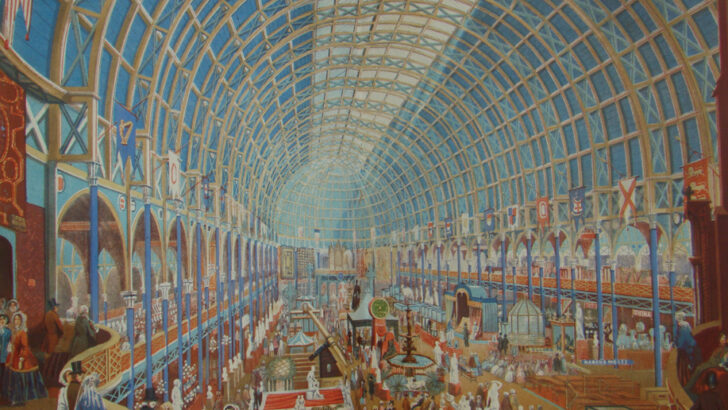An exhibition at both the RDS and the RIA
Though many people may be unfamiliar with the libraries of the Royal Dublin Society or of the Royal Irish Academy, both founded in the mid-18th Century, these hallowed institutions are currently mounting in succession a small but very interesting exhibition relating to the Dublin Great Industrial Exhibition of 1853.
That was one of the most important events in the history of the city, and by extension in the country, but seems to be hardly known to those who talk so much about post-Famine Ireland.
The London Great Exhibition of 1851 inspired many other exhibitions held in the second half of the 19th Century across Europe and North America. The Great Exhibition in London in 1851 for most historians is simply ‘the’ Great Exhibition.
It was imitated in New York in 1853, in Paris in 1855, and in London again in 1865. The exhibition in Dublin could not have hoped to compete with them.
But what it could do was show people who might be disheartened by the effects of the Famine, what was actually being achieved in Ireland.
But think also that when later Patrick Pearse and others spoke of increasing the population again to the pre-Famine eight million, they saw this being done again on the back of agriculture.
The Exhibition of 1853 and those who inspired it, and those who were later inspired by it in turn, had a different vision, that art and industry would provide new sources of occupation beyond cattle, corn and potatoes.
Perhaps Dublin was divorced from rural Ireland. Remember that in these years the great department store in the middle of what is now O’Connell Street also opened.
It is now known as Clerys, but back then was McSwiney and Delaney’s. Mr McSwiney was several times Lord Mayor of Dublin (and a relative of John Joyce, who himself was the secretary of a Dublin distillery).
Admiring
English economists wrote in the British papers in admiring terms about Dublin’s ‘Monster stores’ as something new. Indeed, in my interpretation the big store in O’Connell Street has to be recognised as the very first purpose built department store (rather than a conversion of a run of separate shops), not just in the British Isles, or Europe, but in the World.
What was on show on Merrion Square in 1853, supported by Ireland’s pioneering rail way developer, William Dargan, who saw that only interconnected development would provide a future for Ireland, were the products of Ireland’s manufacturers, great and small, and the outcome of creative work by Irish artists, designers, technicians and crafts people of many kinds.
The documents and images on display here, thanks to the careful curation of Cora McDonagh and Natasha Serne, can only give a glimpse of what it was like. They have drawn on the materials in the archives and library of the RDS to illustrate their theme.
But the city and the country was left with a lasting inheritance, which still thrives and enjoys an international reputation, the National Gallery, erected on the site of the exhibition in Merrion Square. A larger than life statue of Dargan stands outside.
The Dublin exhibition of 1853 was an extraordinary affair, and truly deserves to be better known, for it provided the people of that time with other perspectives on what Ireland might become, and what Irish genius and talent could create. In its exhibits we can detect the remote origin of the ebullience out of which the ‘Celtic tiger’ was born and from which the high tech country of today would emerge.
Post-Famine Ireland was not entirely a place of gloom. In Dublin at least and through the spread rail system and the emergence of a wide spread newspaper industry, a wholly new Ireland could be glimpsed. Let us remember that not everyone of talent had fled abroad.
‘Art and Industry: The Role of the RDS in the Organisation of The Dublin Great Industrial Exhibition of 1853’, at the RDS library, Ballsbridge until Friday, December 15, and at the RIA library, 19 Dawson Street, Wednesday, November 8-Thursday, December 21, 2023. Both venues are open to the public free of charge.


 Peter Costello
Peter Costello A view of the Dublin Exhibition, from John Sproule (ed.) The Irish Industrial Exhibition of 1853 (Dublin: James McGlashan, 1854); courtesy of the Archives and Library of the RDS
A view of the Dublin Exhibition, from John Sproule (ed.) The Irish Industrial Exhibition of 1853 (Dublin: James McGlashan, 1854); courtesy of the Archives and Library of the RDS 